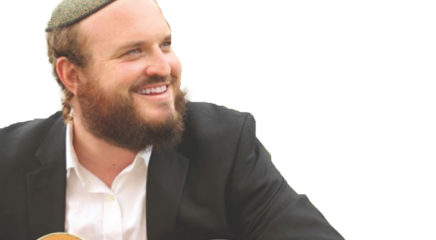Album: Vehakohanim
Composer: Shlomo Katz
YEAR: 2004
One Erev Shabbos in April 2004 Shlomo Katz found himself near his grandparents’ kevarim in Passaic New Jersey. Standing as close to the gravesites as halachah permits (he’s a Kohein) he thought longingly of wishing them Good Shabbos. And then and there the melody of his Shabbos Kodesh song came into his mind fully formed with Yiddish words: “Oy yoy Mamme zisse / Oy yoy Tatte zisse / Oy yoy alle Yidden / Oy Good Shabbos Good Shabbos.”
Back home in Efrat Israel he changed the words to the current version a heartwarming song that is guaranteed to get any crowd singing and clapping along to “Yismechu b’malchuscha Shomrei Shabbos v’korei oneg ” and then the repetitious “Oy yoy Shabbos Kodesh Oy yoy Shabbos Kodesh.”
The new song debuted in Yeshivas Lev Hatorah in Beit Shemesh. “It was a Thursday night and I was looking to share a new niggun with the bochurim so I taught them “Shabbos Kodesh.” We sung it for a full 45 minutes then on the following Shabbos they used it for Lecha Dodi too.” But Katz immersed in learning for his semichah at Yeshivat HaMivtar didn’t get around to recording the song professionally for another two years.
As befits a devotee of Shlomo Carlebach’s musical style the key to Katz’s most popular song is its simplicity. “It’s such a simple niggun with such simple words but a Jew needs to say nothing more about Shabbos than “oy yoy Shabbos Kodesh ” he says. “Maybe maybe hopefully it’s some of our generation’s version of “Yiddelach shrei Shabbos — a scream for the holy gift of Shabbos.”
Shlomo was born into a musical home singing from the time he was a child with his father well-known chazzan and musician Avshalom Katz. The house was full of music and song: zemiros Reb Shlomo Carlebach The Rabbi’s Sons and eclectic other musical influences. Shlomo started to compose music as a teenager while he was still sharing a room with his younger brother singer Eitan Katz (of L’maancha fame). “One of us would come up with the lower part and the other with the second part and that is how some of our niggunim were composed.”
But it was when he came back to Eretz Yisrael at age 22 made aliyah and forged his own personal connection to the Holy Land that the gates of inspiration opened and Shlomo’s niggunim began to pour forth in earnest. His lively wordless “Niggun Nevo ” for example was inspired and named after a Shabbos spent in the Mizpeh Nevo neighborhood of Maaleh Adumim. “That niggun came down to me on Friday night and I had to sing it the whole Shabbos to keep it in my memory ” he says.
One of the highlights of the musical journey on which Shlomo Katz’s hit Shabbos song took him was the privilege of taking part in the very first Shabbos Project which took place in South Africa in 2013 under the pioneering leadership of South Africa’s chief rabbi Warren Goldstein.
“I went to Johannesburg for that most amazing Shabbos ” he says. “On Motzaei Shabbos we had a massive concert attended by about 7 000 people who had just kept Shabbos for the very first time. Singing ‘Shabbos Kodesh’ together with them was a moment I’ll never forget.”
Today as rav of the Shirat David kehillah in Efrat Israel Reb Shlomo says his life is “half and half”: he’s teaching Torah while still involved in music singing and playing niggunim that ignite the Jewish neshamah.
Yet he prefers to steer clear of huge concert settings in favor of smaller intimate events. “Small kumzitzes and gatherings in people’s homes are my personal favorite venue. That’s when I feel most connected to the niggunim and the inspiration behind them.”
“One night I was a guest at the bar mitzvah of the son of violinist Daniel Ahaviel. A young waiter kept coming over and going out of his way for us and eventually he told me that he had stopped being shomer Shabbos years ago — until someone had played him the ‘Shabbos Kodesh’ song. He told me ‘I can’t bring myself to be mechallel Shabbos anymore.’ That encounter was so humbling. An undeserved gift. I feel I should say Hallel for the impact on that neshamah alone.” (Originally featured in Mishpacha Issue 664)




